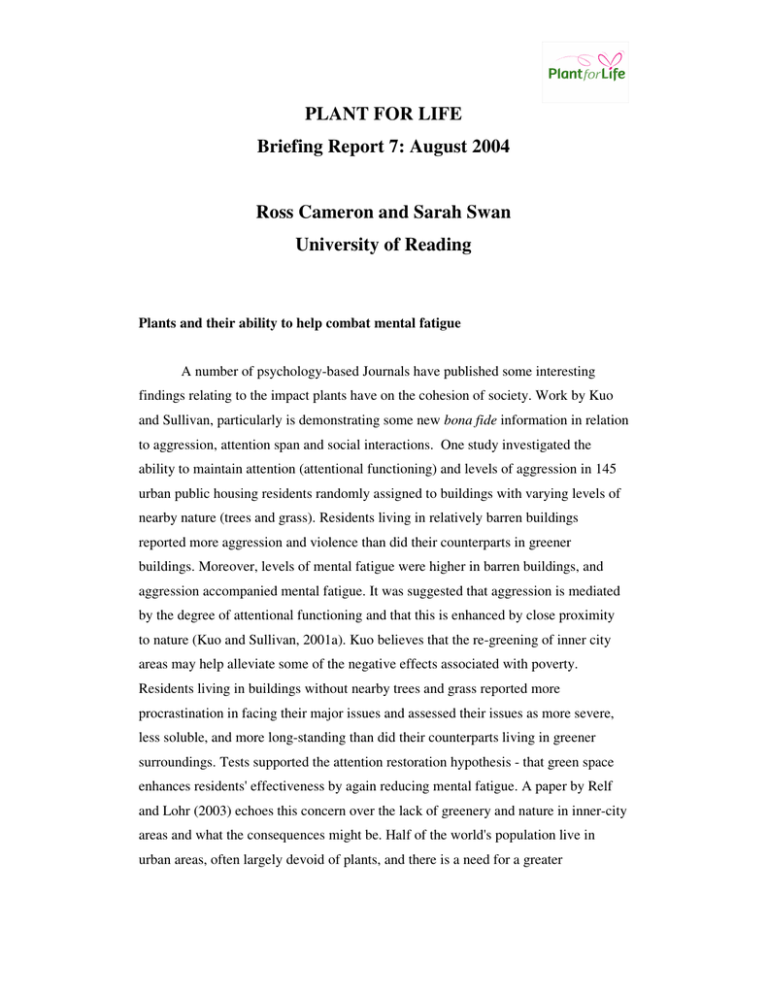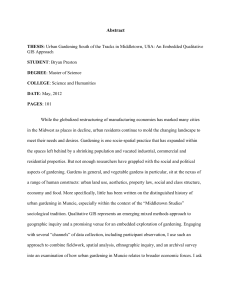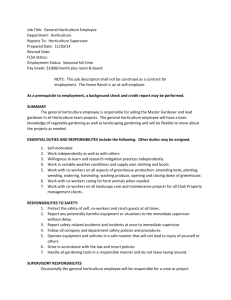PLANT FOR LIFE Briefing Report 7: August 2004
advertisement

PLANT FOR LIFE Briefing Report 7: August 2004 Ross Cameron and Sarah Swan University of Reading Plants and their ability to help combat mental fatigue A number of psychology-based Journals have published some interesting findings relating to the impact plants have on the cohesion of society. Work by Kuo and Sullivan, particularly is demonstrating some new bona fide information in relation to aggression, attention span and social interactions. One study investigated the ability to maintain attention (attentional functioning) and levels of aggression in 145 urban public housing residents randomly assigned to buildings with varying levels of nearby nature (trees and grass). Residents living in relatively barren buildings reported more aggression and violence than did their counterparts in greener buildings. Moreover, levels of mental fatigue were higher in barren buildings, and aggression accompanied mental fatigue. It was suggested that aggression is mediated by the degree of attentional functioning and that this is enhanced by close proximity to nature (Kuo and Sullivan, 2001a). Kuo believes that the re-greening of inner city areas may help alleviate some of the negative effects associated with poverty. Residents living in buildings without nearby trees and grass reported more procrastination in facing their major issues and assessed their issues as more severe, less soluble, and more long-standing than did their counterparts living in greener surroundings. Tests supported the attention restoration hypothesis - that green space enhances residents' effectiveness by again reducing mental fatigue. A paper by Relf and Lohr (2003) echoes this concern over the lack of greenery and nature in inner-city areas and what the consequences might be. Half of the world's population live in urban areas, often largely devoid of plants, and there is a need for a greater understanding of the connection between ornamental plants and mental, social and environmental health. The impact of plants and greenery on attentional functioning may also explain why children with attention deficit disorder (ADD) appear to respond better when playing in a green or natural environment (FaberTaylor et al., 2001). In this study, parents were surveyed regarding their child's attentional functioning after activities in several settings. Results indicate that children function better than usual after activities in green settings and that the 'greener' a child's play area, the less severe his or her attention deficit symptoms. Thus, contact with nature may support attentional functioning in children who need attentional support. Kuo’s group also investigated the relationship between crime and greenery in the urban environment (Kuo and Sullivan, 2001b). Although vegetation has been positively linked to fear of crime in a number of settings, these findings hinted at a possible negative relationship. Residents living in 'greener' surroundings report lower levels of fear, more civil behaviour, and less aggressive and violent behaviour. This study used police crime reports to examine the relationship between vegetation and crime in an inner-city neighbourhood. Crime rates for 98 apartment buildings with varying levels of nearby vegetation were compared. Results indicate that the greener a building's surroundings were, the fewer the number of crimes reported. Furthermore, the pattern held for both property crimes and violent crimes. Health and sociological benefits associated with gardening BUPA have summarised a number or recent research initiatives on their website (http://www.bupa.co.uk/health_information/html/healthy_living/senior/gardening/fitn ess.html). Including in this are recommendations to how gardening can keep you fit and healthy: • It is a form of moderate exercise, and active gardening such as digging is likely to help prevent type II diabetes, heart disease and strokes. Unlike other forms of exercise, many do not consider active gardening as a chore. • It is an activity ideally suited for elderly people. Working with hands and limbs particularly can help relaxation. It also gives the opportunity for creative mental active via learning and problem solving. In one survey carried out by the charity MIND, 50 per cent of people believed that physical exercise (including gardening) was one of the best activities to boost their mental health. Older people in particular, can benefit from positive influences associated with promoting interest, self-esteem and enthusiasm for the future. • Stress reduction; researchers at the University of Florida have found that just walking through a botanical garden lowered people's stress levels. • Meeting up with other gardeners who share the same interests can provide stimulating conversation. Gardening can produce a sense of responsibility and a focus for the mind and can help rehabilitate and improve self-worth in people who have had had strokes or accidents. Work carried out by Lancaster University’s Institute for Health Research in its project ‘Cultivating Health’ echoes a number of similar points (Milligan et al., 2003). It suggests that gardening and social activities have profound and positive effects on a person’s sense of worth and mental well-being. These effects support older people to cope better with chronic or debilitating physical ill health. The survey found in particular, that social contact was a vital factor in enhancing the health and well-being of older people whatever activity they are involved in. Gardening ‘communally’ within a club was an ideal way to reap the benefits of both physical and social activities. Importantly, it was noted that the organisation and choice of activities in clubs should be entirely guided by the participants and that this is the key to success. An interesting anecdote to this area, although not related to gardening directly, was some recent research carried out at the University of Wolverhampton (Morrris, 2002). This study investigated the use of lavender baths to improve aspects of psychological well-being, namely positive mood state and a positive outlook with respect to the future. Participants were randomly allocated to use either grapeseed oil or 80% grapeseed oil and 20% lavender oil in their bath for 14 days. The UWIST mood adjective checklist and MacLeod and Byrne Future Events procedure were used as assessment criteria . Psychologically positive mood changes were found after the bathing regimen for energetic arousal, tense arousal, hedonic tone and angerfrustration. Only anger-frustration showed a selective effect for lavender oil. In a second study negative responses about the future were selectively reduced after lavender oil baths. Whether certain plant aromas can induce some of these effects outwith the bath setting were not mentioned ! Gardening and ‘added value’ Recent statistics from the National Gardening Association in the USA have shown some interesting trends with the influence gardening has on lifestyle and property value (Butterfield, 2004). Seventy-eight percent (84 million households) participated in one or more types of do-it-yourself indoor and outdoor lawn and garden activities in 2003, a figure similar to that of 2002. Consumers spent an average of $457 per household on their lawns and gardens in 2003. Over the past 5 years, total lawn and garden sales have increased at a compound annual growth rate of 5%. From 1998-2003 lawn and garden sales increased from $30.2 billion in 1998 to $38.4 billion in 2003. The report states that “The most important consumers of lawn and garden products last year were men, people 45 and older, college graduates, households with no children at home, households in the Northeast, South and West, married households, 2-person households, and households with annual incomes over $75,000”. The economic benefits of a well-landscaped garden have also merited further review. Studies at Clemson University (Henry, 1994) showed that a house that obtained an excellent landscape rating from a local landscaping professional could expect a sale price 4 to 5 percent higher than equivalent houses with good landscaping. A point to note was that homes with landscaping ranked poor relative to neighbouring homes could expect a sale price 8 to 10 percent below equivalent homes with good landscape appeal. According to Judith Guido, director of marketing for TruGreen-LandCare, landscaping can add as much as 14 % resale value to a building and speed the sale of a building by as much as six weeks. (Van Fleet, 2004). Other studies (Taylor, 2003) suggest that by spending 5% of the value of the home on the installation of a quality low-maintenance landscape could boost the resale value by 15%, earning back 150% or more on the landscape investment. In Quebec a survey found that hedges raised property values by 3.6%, a landscaped curb by 4.4%, and a landscaped patio by 12.4%. A series of reports from the Centre for Urban Horticulture at the University of Washington (Wolf,1998 a-c, 2000) that focussed on the commercial sector stated that: • An interview-based survey of business owners and business association staff indicates that trees and landscaping in neighbourhood commercial districts; 1/ create a pleasant space that attracts people; 2/ act as an outdoor extension of the business’ customer service commitment; and 3/ can help to develop a distinctive identity for and define the boundaries of a business district, thereby encouraging return visits. • 74% of the public preferred to patronize commercial establishments that had structures and parking lots planted with trees and other landscaping. • A survey of consumers in eight U.S. cities showed that retail shopping districts with an orderly and well-maintained planting scheme, including both trees and accessory vegetation, received the highest visual quality ratings. • A mail survey of licensed drivers in Washington State found that the presence of trees and green space appears to positively influence both consumers’ attitudes about the character of a place and the prices that shoppers are willing to pay in local businesses. References Anon (2004) http://www.bupa.co.uk/health_information/html/healthy_living/senior/gardening/fitne ss.html Butterfield B. (2004) NGA Announces Lawn & Garden Market Statistics for 2003. http://www.nationalgardening.com/RSRCH/feature.asp FaberTaylor A, Kuo FE, Sullivan WC. (2001) Coping with ADD: the surprising connection to green play settings. Environment and behaviour, 33:54-77. Kuo FE. (2001) Coping with poverty: impacts of environment and attention in the inner city. Environment and behaviour, 33:5-34. Kuo FE, Sullivan WC. (2001a) Aggression and violence in the inner city: effects of environment via mental fatigue. Environment and behaviour, 33: 543-571 Kuo FE, Sullivan WC. (2001b) Environment and crime in the inner city: does vegetation reduce crime? Environment and behaviour, 33: 343-367. Morrris A. (2002) The effects of lavender (Lavandula angustifolium) baths on psychological well-being: two exploratory randomised control trials. Complementary Therapies in Medicine, 10: 223-228. Milligan C, Bingley A and Gatrell A. (2003) Cultivating Health: a study of health and mental well-being amongst older people in Northern England, Final Research Report, October 2003. Institute for Health Research, Lancaster University. Relf PD and Lohr VI. (2003) Human issues in horticulture. Hortscience, 38: 984-993. Taylor C. (2003) “Fertile Ground”. Smart Money, March 2003. http://www.smartmoney.com/mag/index.cfm?story=march03-cover Van Fleet B. (2004) http://www.igin.com/Landscaping/economic.html Wolf KL. (1998a) Centre for Urban Horticulture, University of Washington College of Forest Resources, 1998. Growing with Green: Business Districts and the Urban Forest. Human Dimensions of the Urban Forest Fact Sheet No. 2. Wolf KL. (1998b) Centre for Urban Horticulture, University of Washington College of Forest Resources, 1998. Urban Forest Values: Economic Benefits of Trees in Cities”. Human Dimensions of the Urban Forest Fact Sheet No. 3. Wolf, K.L. (1998c) Centre for Urban Horticulture, University of Washington College of Forest Resources, 1998. Trees in Business Districts: Comparing Values of Consumers and Business. Human Dimensions of the Urban Forest Fact Sheet No. 4. Wolf KL. (2000) Centre for Urban Horticulture, University of Washington College of Forest Resources, 2000. Community Image: Roadside Settings and Public Perceptions. Human Dimensions of the Urban Forest Fact Sheet No. 10. Campaign financed with aid from the European Union






